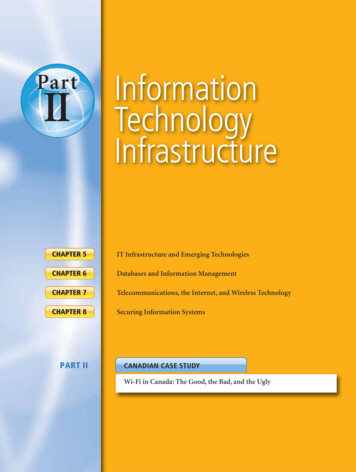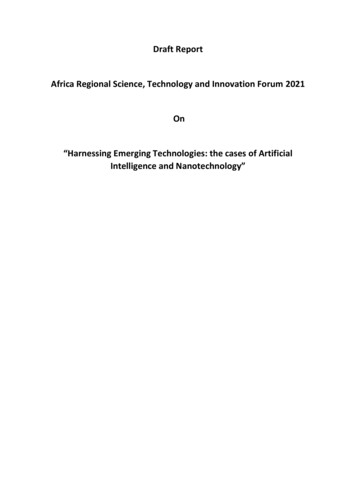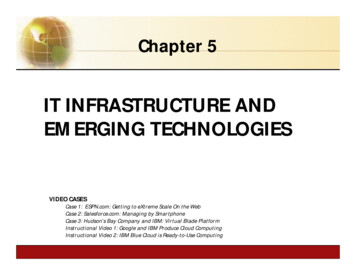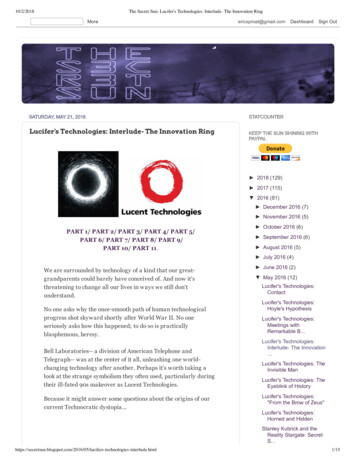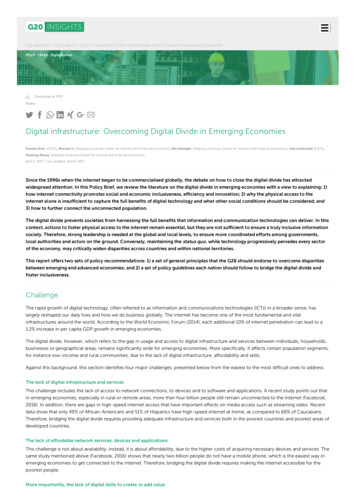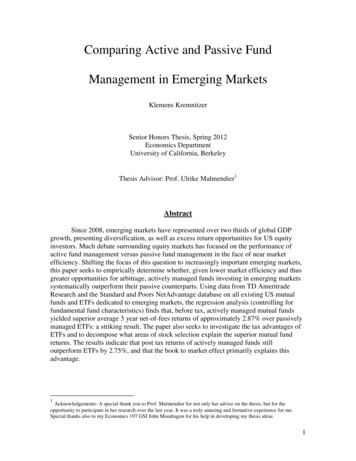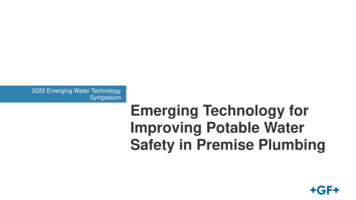
Transcription
Chapter 5IT Infrastructure and EmergingTechnologiesLEARNING OBJECTIVESCHAPTER OUTLINEAfter reading this chapter, youwill be able to answer thefollowing questions:5.11. What is IT infrastructure and whatare its components?2. What are the stages and technologydrivers of IT infrastructure evolution?3. What are the current trends in computer hardware platforms?4. What are the current trends in software platforms?5. What are the challenges of managing IT infrastructure and management solutions?Interactive Sessions:Should You Use Your iPhonefor Work?Nordea Goes Green with ITIT INFRASTRUCTUREDefining IT InfrastructureEvolution of IT InfrastructureTechnology Drivers of Infrastructure Evolution5.2 INFRASTRUCTURE COMPONENTSComputer Hardware PlatformsOperating System PlatformsEnterprise Software ApplicationsData Management and StorageNetworking/Telecommunications PlatformsInternet PlatformsConsulting and System Integration Services5.3 CONTEMPORARY HARDWARE PLATFORM TRENDSThe Emerging Mobile Digital PlatformConsumerization of IT and BYODGrid ComputingVirtualizationCloud ComputingGreen ComputingHigh-Performance and Power-Saving ProcessorsAutonomic Computing5.4 CONTEMPORARY SOFTWARE PLATFORM TRENDSLinux and Open Source SoftwareSoftware for the Web: Java, HTML, and HTML5Web Services and Service-Oriented ArchitectureSoftware Outsourcing and Cloud Services5.5 MANAGEMENT ISSUESDealing with Platform and Infrastructure ChangeManagement and GovernanceMaking Wise Infrastructure InvestmentsLEARNING TRACK MODULESHow Computer Hardware and Software WorkService Level AgreementsThe Open Source Software InitiativeComparing Stages in IT Infrastructure EvolutionCloud Computing
TREFORMING THE REGULATORY SYSTEM FORCONSTRUCTION PERMITShe Singapore Government envisions a need to transform the building and construction industry through the Construction 21 Blueprint and a strategic vision to becomea “World Class Builder in the Knowledge Age”. The increased use of IT is critical forthis government to realize its vision, primarily because of the symbiotic relationshipbetween technology and knowledge. Clearly, in a knowledge-based industry, organizations mustleverage technologies as a means to improve productivity, reduce costs and enhance the quality of products and services. Government efforts have to focus on developing a set of IT infrastructure projects to provide businesses and other organizations with the means to streamlinebusiness processes and workflow, and maximize the use of information to gain and sustain theircompetitive advantage.The CORENET project (COnstruction and Real Estate NETwork) has come a long way, sinceits launch in 1995, to become a major IT initiative. Led by the Ministry of National Developmentand driven by the Building and Construction Authority with the purpose of re-engineering thebusiness processes of the building and construction industry to achieve great improvementsin turnaround time, productivity and quality. CORENET revolves around developing IT systems and key infrastructure to integrate the four major processes of a building project life cycle,namely, design, procurement, build, and maintenance. One of the goals of CORENET is to implement an appropriate IT infrastructure to facilitate participants of building projects, includingthe planning authorities, to exchange information seamlessly and speedily. In essence, puttingin place a government-to-business (G2B) infrastructure enables businesses to make electronicbuilding plan submissions for obtaining approvals and permits from the 16 government authorities across eight ministries that regulate activities of the industry. The internet-based system canhandle project-related documents for the whole project life cycle, from processing of buildingplans and documents related to the issuance of development planning approvals, building plansapproval, structural plans approvals, temporary occupation permits, fire safety certificates andcertificates of statutory completion.Traditionally, the whole construction process comprises four distinct sequential stages. Theyare design, tender documentation and selection, construction, and handover and maintenance.In the first stage, the key activities of design consist of developing concept and schematic designs,and obtaining planning approvals. As planning approvals are granted by the various regulatorybodies, the building ownerneeds to submit the buildingplans through the appointeddesign consultant (or theQualified Person) to thesebodies separately to applyfor the approvals. The complex process of submitting theapplication, checking againstplanning requirements, evaluating the proposal, re-submission for non-complianceand issuing approval involvesmany parties and uses different channels of communication. In the traditional (or old)process, the ‘Qualified Person’has to make multiple submis leungchopan/Shutterstocksions of plans, documents and193
194Part Two Information Technology Infrastructureapplications to different authorities, resulting in voluminous paper documents generated,inefficient manual processing of submissions by the regulatory agencies, insufficient storagespace for all the paper documents and disorganized exchange of project information amongproject team members.How can an IT infrastructure help to improve the submissions process in this situation?CORENET’s e-submission system provides a virtual one-stop 24/7 counter to facilitate electronic submission of building plans and documents to multiple regulatory agencies, onlineenquiry of submission status, integrated application with fee collection, quicker processing and turnaround time of an application, and elimination of (hardcopy) printing of plans,documents and application forms. In other words, by allowing industry players to submittheir applications over the Internet, they do not need to make hardcopy prints of the plansand documents nor travel physically to the premises of the government agencies to submitthem. The element of transparency is also enhanced as all parties involved are able to monitor online the status and progress of the planning applications made.The Singapore Government ascertains the amount of cost savings derived from the use ofthe e-submission system as an estimated S 450 (equivalent to about US 368) for each submission. The amount is estimated from the reduction in hardcopy prints of plans and documents, as well as elimination of manual dispatching of documents to the various authoritiesconcerned. Further results from an industry-wide survey of 754 companies show that themajority of them (77.1 percent) have found it to be beneficial to their work. This high percentage obtained helps to register a relatively firm adoption of the new system, as well asgood success of its implementation.Sources: Building and Construction Authority, “Construction and Real Estate Network (CORENET)”. Websitevisited on November 1, 2012, athttp://www.corenet.gov.sg. Goh, B.H., “e-Government for Construction: TheCase of Singapore’s CORENET Project”. In proceedings of the IFIP TC 8 WG 8.9 International Conferenceon Research and Practical Issues of Enterprise Information Systems, Beijing, China, October 14, 2007. Lim,B.H., “The CORENET Project in Singapore”. Article retrieved on November 1, 2012, from cs/20060228 CORENET case study.pdfThis case is contributed by Bee Hua Goh, National University of SingaporeThe CORENET project illustrates a government’s strategic plan and initiatives to transform the building and construction industry from one that is traditional into anotherthat is more knowledge-based. An IT infrastructure is implemented to allow businesses andother organizations to collaborate with one another in order to share and exchange commonbuilding project information.More specifically, it illustrates how the setting up of a G2B (internet-based) infrastructurecan help the industry as a whole to rationalize its practice and processes for building planssubmissions. Significant improvement in turnaround time for each application is evidentwhich translates into measurable cost savings. In other words, without the IT infrastructure,the various private and public organizations would have to work in isolation, resulting induplication of work, wastage of time and other resources, as well as a lack of integration andtransparency of the application process.The benefits, in terms of tangible and intangible, are obvious to everyone who participatesin the process of obtaining and granting planning approvals and permits for constructionwork. But there is an added advantage for organizations in the construction industry. Theaccumulation of project information (or knowledge) that is stored digitally can be easilyretrieved for subsequent use. Knowledge reuse is most valuable in construction projects aseach project contains the relevant best practices that can be repeated in other projects toensure better success in them.Here are some questions to think about: How did CORENET’s e-submission system facilitate businesses and other organizations in streamlining their business processes and workflow? How are the businesses and other organizations benefiting from CORENET’s G2Binfrastructure for building plans submission?
Chapter 5 IT Infrastructure and Emerging Technologies Identify the need to re-engineerthe business process ofconstructionBusinessChallenges Lead sixteen governmentauthorities to cooperateManagementCreate a single authorityto build the CORENETto integrate processesOrganization Voluminous paper documentsInefficient processingNo central repositoryIneffective collaborationInformationSystemBusinessSolutions Internet-based governmentto business infrastructure5.1ITechnology Build a documentmanagement systemCreate a single networkto coordinate the flow ofplans and approvals forconstruction projects Enable electronicdocument submissionProvide online queryand trackingCombine application andfee accountingEliminate printing of plansIT INFRASTRUCTUREn Chapter 1, we defined information technology (IT) infrastructure as theshared technology resources that provide the platform for the firm’sspecific information system applications. An IT infrastructure includesinvestment in hardware, software, and services—such as consulting,education, and training—that are shared across the entire firm or across entirebusiness units in the firm. A firm’s IT infrastructure provides the foundation forserving customers, working with vendors, and managing internal firm businessprocesses (see Figure 5.1).Supplying firms worldwide with IT infrastructure (hardware and software)in 2012 is estimated to be a 3.6 trillion industry when telecommunications,networking equipment, and telecommunications services (Internet, telephone,and data transmission) are included. This does not include IT and related businessprocess consulting services, which add another 400 billion. Investments ininfrastructure account for between 25 and 50 percent of information technologyexpenditures in large firms, led by financial services firms where IT investmentis well over half of all capital investment.DEFINING IT INFRASTRUCTUREAn IT infrastructure consists of a set of physical devices and software applications that are required to operate the entire enterprise. But an IT infrastructureis also a set of firmwide services budgeted by management and comprisingboth human and technical capabilities. These services include the following: Computing platforms used to provide computing services that connectemployees, customers, and suppliers into a coherent digital environment,including large mainframes, midrange computers, desktop and laptopcomputers, and mobile handheld and remote cloud computing services. Telecommunications services that provide data, voice, and video connectivityto employees, customers, and suppliers195
196Part Two Information Technology InfrastructureFIGURE 5.1CONNECTION BETWEEN THE FIRM, IT INFRASTRUCTURE, ANDBUSINESS CAPABILITIESThe services a firm is capable of providing to its customers, suppliers, and employees are a directfunction of its IT infrastructure. Ideally, this infrastructure should support the firm’s business andinformation systems strategy. New information technologies have a powerful impact on business andIT strategies, as well as the services that can be provided to customers. Data management services that store and manage corporate data and providecapabilities for analyzing the data Application software services, including online software services, thatprovide enterprise-wide capabilities such as enterprise resource planning,customer relationship management, supply chain management, andknowledge management systems that are shared by all business units Physical facilities management services that develop and manage thephysical installations required for computing, telecommunications, and datamanagement services IT management services that plan and develop the infrastructure, coordinate with the business units for IT services, manage accounting for the ITexpenditure, and provide project management services IT standards services that provide the firm and its business units withpolicies that determine which information technology will be used, when,and how IT education services that provide training in system use to employees andoffer managers training in how to plan for and manage IT investments IT research and development services that provide the firm with researchon potential future IT projects and investments that could help the firmdifferentiate itself in the marketplaceThis “service platform” perspective makes it easier to understand thebusiness value provided by infrastructure investments. For instance, thereal business value of a fully loaded personal computer operating at 3 gigahertz that costs about 1,000 and a high-speed Internet connection is hard tounderstand without knowing who will use it and how it will be used. Whenwe look at the services provided by these tools, however, their value becomes
Chapter 5 IT Infrastructure and Emerging Technologiesmore apparent: The new PC makes it possible for a high-cost employee making 100,000 a year to connect to all the company’s major systems and the publicInternet. The high-speed Internet service saves this employee about one hourper day in reduced wait time for Internet information. Without this PC andInternet connection, the value of this one employee to the firm might be cutin half.EVOLUTION OF IT INFRASTRUCTUREThe IT infrastructure in organizations today is an outgrowth of over 50 yearsof evolution in computing platforms. There have been five stages in thisevolution, each representing a different configuration of computing powerand infrastructure elements (see Figure 5.2). The five eras are general-purpose mainframe and minicomputer computing, personal computers, client/server networks, enterprise computing, and cloud and mobile computing.Technologies that characterize one era may also be used in another timeperiod for other purposes. For example, some companies still run traditionalmainframe systems or use mainframe computers as massive servers supportinglarge Web sites and corporate enterprise applications.General-Purpose Mainframe and Minicomputer Era:(1959 to Present)The introduction of the IBM 1401 and 7090 transistorized machines in 1959marked the beginning of widespread commercial use of mainframe computers.In 1965, the mainframe computer truly came into its own with the introductionof the IBM 360 series. The 360 was the first commercial computer with a powerful operating system that could provide time sharing, multitasking, and virtualmemory in more advanced models. IBM has dominated mainframe computingfrom this point on. Mainframe computers became powerful enough to supportthousands of online remote terminals connected to the centralized mainframeusing proprietary communication protocols and proprietary data lines.The mainframe era was a period of highly centralized computing under thecontrol of professional programmers and systems operators (usually in a corporate data center), with most elements of infrastructure provided by a singlevendor, the manufacturer of the hardware and the software.This pattern began to change with the introduction of minicomputers produced by Digital Equipment Corporation (DEC) in 1965. DEC minicomputers(PDP-11 and later the VAX machines) offered powerful machines at far lowerprices than IBM mainframes, making possible decentralized computing, customized to the specific needs of individual departments or business units rather thantime sharing on a single huge mainframe. In recent years, the minicomputer hasevolved into a midrange computer or midrange server and is part of a network.Personal Computer Era: (1981 to Present)Although the first truly personal computers (PCs) appeared in the 1970s (theXerox Alto, the MITS Altair 8800, and the Apple I and II, to name a few), thesemachines had only limited distribution to computer enthusiasts. The appearanceof the IBM PC in 1981 is usually considered the beginning of the PC era becausethis machine was the first to be widely adopted by American businesses. At firstusing the DOS operating system, a text-based command language, and later theMicrosoft Windows operating system, the Wintel PC computer (Windows operating system software on a computer with an Intel microprocessor) became thestandard desktop personal computer. In 2012, there are an estimated 1.2 billion197
198Part Two Information Technology InfrastructureFIGURE 5.2ERAS IN IT INFRASTRUCTURE EVOLUTIONIllustrated here are the typical computing configurations characterizing each of the five eras of ITinfrastructure evolution.
Chapter 5 IT Infrastructure and Emerging TechnologiesPCs in the world, and 300 million new PCs are sold each year. 90% are thoughtto run a version of Windows, and 10% run a Macintosh OS. The Wintel dominance as a computing platform is receding as iPhone and Android device salesincrease. Nearly one billion people worldwide own smartphones, and most ofthese users access the Internet with their mobile devices.Proliferation of PCs in the 1980s and early 1990s launched a spate of personaldesktop productivity software tools—word processors, spreadsheets, electronicpresentation software, and small data management programs—that were veryvaluable to both home and corporate users. These PCs were stand-alone systemsuntil PC operating system software in the 1990s made it possible to link theminto networks.Client/Server Era (1983 to Present)In client/server computing, desktop or laptop computers called clients arenetworked to powerful server computers that provide the client computerswith a variety of services and capabilities. Computer processing work is splitbetween these two types of machines. The client is the user point of entry,whereas the server typically processes and stores shared data, serves up Webpages, or manages network activities. The term “server” refers to both the software application and the physical computer on which the network softwareruns. The server could be a mainframe, but today, server computers typicallyare more powerful versions of personal computers, based on inexpensive chipsand often using multiple processors in a single computer box., or in serverracks.The simplest client/server network consists of a client computernetworked to a server computer, with processing split between the two typesof machines. This is called a two-tiered client/server architecture. Whereassimple client/server networks can be found in small businesses, most corporations have more complex, multitiered (often called N-tier) client/server architectures in which the work of the entire network is balancedover several different levels of servers, depending on the kind of service beingrequested (see Figure 5.3).For instance, at the first level, a Web server will serve a Web page to aclient in response to a request for service. Web server software is responsibleFIGURE 5.3A MULTITIERED CLIENT/SERVER NETWORK (N-TIER)In a multitiered client/server network, client requests for service are handled by different levels ofservers.199
200Part Two Information Technology Infrastructurefor locating and managing stored Web pages. If the client requests access to acorporate system (a product list or price information, for instance), the requestis passed along to an application server. Application server software handles all application operations between a user and an organization’s back-endbusiness systems. The application server may reside on the same computeras the Web server or on its own dedicated computer. Chapters 6 and 7 providemore detail on other pieces of software that are used in multitiered client/server architectures for e-commerce and e-business.Client/server computing enables businesses to distribute computing workacross a series of smaller, inexpensive machines that cost much less than centralized mainframe systems. The result is an explosion in computing power andapplications throughout the firm.Novell NetWare was the leading technology for client/server networking atthe beginning of the client/server era. Today, Microsoft is the market leaderwith its Windows operating systems (Windows Server, Windows 8, Windows 7,and Windows Vista).Enterprise Computing Era (1992 to Present)In the early 1990s, firms turned to networking standards and software tools thatcould integrate disparate networks and applications throughout the firm into anenterprise-wide infrastructure. As the Internet developed into a trusted communications environment after 1995, business firms began seriously using theTransmission Control Protocol/Internet Protocol (TCP/IP) networking standard totie their disparate networks together. We discuss TCP/IP in detail in Chapter 7.The resulting IT infrastructure links different pieces of computer hardwareand smaller networks into an enterprise-wide network so that information can flow freely across the organization and between the firm and otherorganizations. It can link different types of computer hardware, includingmainframes, servers, PCs, and mobile devices, and it includes public infrastructures such as the telephone system, the Internet, and public network services.The enterprise infrastructure also requires software to link disparate applications and enable data to flow freely among different parts of the business, suchas enterprise applications (see Chapters 2 and 9) and Web services (discussedin Section 5.4).Cloud and Mobile Computing Era (2000 to Present)The growing bandwidth power of the Internet has pushed the client/servermodel one step further, towards what is called the “Cloud Computing Model.”Cloud computing refers to a model of computing that provides access to ashared pool of computing resources (computers, storage, applications, andservices) over a network, often the Internet. These “clouds” of computingresources can be accessed on an as-needed basis from any connected deviceand location. Currently, cloud computing is the fastest growing form of computing, with companies spending about 109 billion on public cloud services in2012, and an estimated 207 billion by the end of 2016 (Gartner, 2012).Thousands or even hundreds of thousands computers are located in cloud datacenters, where they can be accessed by desktop computers, laptop computers,tablets, entertainment centers, smartphones, and other client machines linked tothe Internet, with both personal and corporate computing increasingly movingto mobile platforms. IBM, HP, Dell, and Amazon operate huge, scalable cloudcomputing centers that provide computing power, data storage, and high-speedInternet connections to firms that want to maintain their IT infrastructures
Chapter 5 IT Infrastructure and Emerging Technologiesremotely. Software firms such as Google, Microsoft, SAP, Oracle, and Salesforce.com sell software applications as services delivered over the Internet.We discuss cloud and mobile computing in more detail in Section 5.3. TheLearning Tracks include a table titled Comparing Stages in IT InfrastructureEvolution, which compares each era on the infrastructure dimensions introduced.TECHNOLOGY DRIVERS OF INFRASTRUCTUREEVOLUTIONThe changes in IT infrastructure we have just described have resulted fromdevelopments in computer processing, memory chips, storage devices,telecommunications and networking hardware and software, and softwaredesign that have exponentially increased computing power while exponentiallyreducing costs. Let’s look at the most important developments.M o o r e ’s L a w a n d M i c r o p r o c e s s i n g Po w e rIn 1965, Gordon Moore, the director of Fairchild Semiconductor’s Research andDevelopment Laboratories, an early manufacturer of integrated circuits, wrotein Electronics magazine that since the first microprocessor chip was introducedin 1959, the number of components on a chip with the smallest manufacturingcosts per component (generally transistors) had doubled each year. This assertion became the foundation of Moore’s Law. Moore later reduced the rate ofgrowth to a doubling every two years.This law would later be interpreted in multiple ways. There are at least threevariations of Moore’s Law, none of which Moore ever stated: (1) the power ofmicroprocessors doubles every 18 months; (2) computing power doubles every18 months; and (3) the price of computing falls by half every 18 months.FIGURE 5.4MOORE’S LAW AND MICROPROCESSOR PERFORMANCEPacking over 2 billion transistors into a tiny microprocessor has exponentially increased processingpower. Processing power has increased to over 128,000 MIPS (2.6 billion instructions per second).Source: Authors’ estimate.201
202Part Two Information Technology InfrastructureFigure 5.4 illustrates the relationship between number of transistors on amicroprocessor and millions of instructions per second (MIPS), a commonmeasure of processor power. Figure 5.5 shows the exponential decline in thecost of transistors and rise in computing power. For instance, in 2012, you canbuy an Intel i7 quad-core processor on Amazon for about 355, and you will bepurchasing a chip with 2.5 billion transistors, which works out to about one tenmillionth of a dollar per transistor.Exponential growth in the number of transistors and the power of processorscoupled with an exponential decline in computing costs is likely to continue. Chipmanufacturers continue to miniaturize components. Today’s transistors should nolonger be compared to the size of a human hair but rather to the size of a virus.By using nanotechnology, chip manufacturers can even shrink the size oftransistors down to the width of several atoms. Nanotechnology uses individual atoms and molecules to create computer chips and other devices that arethousands of times smaller than current technologies permit. Chip manufacturers are trying to develop a manufacturing process that could produce nanotubeprocessors economically (Figure 5.6). IBM has just started making microprocessors in a production setting using this technology.The Law of Mass Digital StorageA second technology driver of IT infrastructure change is the Law of MassDigital Storage. The amount of digital information is roughly doubling everyyear (Gantz and Reinsel, 2011; Lyman and Varian, 2003). Fortunately, the costof storing digital information is falling at an exponential rate of 100 percent ayear. Figure 5.7 shows that the number of megabytes that can be stored on magnetic media for 1 from 1950 to the present roughly doubled every 15 months.In 2012, a 500 gigabyte hard disk drive sells at retail for about 60.FIGURE 5.5FALLING COST OF CHIPSPacking more transistors into less space has driven down transistor costs dramatically as well as thecost of the products in which they are used.Source: Authors’ estimate.
Chapter 5 IT Infrastructure and Emerging TechnologiesFIGURE 5.6EXAMPLE OF NANOTUBESNanotubes are tiny tubes about 10,000 times thinner than a human hair. They consist of rolled-upsheets of carbon hexagons and have the potential uses as minuscule wires or in ultrasmall electronicdevices and are very powerful conductors of electrical current. Tyler Boyes/Shutterstock.FIGURE 5.7THE AMOUNT OF STORAGE PER DOLLAR RISESEXPONENTIALLY, 1950–2012Amount of Storage Per Dollar 0196019591958195519500Since the first magnetic storage device was used in 1955, the amount of storage a dollar buys hasrisen exponentially, doubling the amount of digital storage for each dollar expended every 15 monthson average.Source: Authors’ estimates.203
204Part Two Information Technology InfrastructureM e t c a l f e ’s L a w a n d N e t w o r k E c o n o m i c sMoore’s Law and the Law of Mass Storage help us understand why computingresources are now so readily available. But why do people want more computing and storage power? The economics of networks and the growth of theInternet provide some answers.Robert Metcalfe—inventor of Ethernet local area network technology—claimed in 1970 that the value or power of a network grows exponentiallyas a function of the number of network members. Metcalfe and others pointto the increasing returns to scale that network members receive as more andmore people join the network. As the number of members in a network growslinearly, the value of the entire system grows exponentially and continues togrow forever as members increase. Demand for information technology hasbeen driven by the social and business value of digital networks, which rapidlymultiply the number of actual and potential links among network members.Declining Communications Costs and the InternetA fourth technology driver transforming IT infrastructure is the rapid declinein the costs of communication and the exponential growth in the size of theInternet. An estimated 2.3 billion people worldwide now ha
IT Infrastructure and Emerging Technologies. 193 T he Singapore Government envisions a need to transform the building and construc-tion industry through the Construction 21 Blueprint and a strategic vision to become a "World Class Builder in the Knowledge Age". The increased use of IT is critical for


